Chao Jiang
MedReadMe: A Systematic Study for Fine-grained Sentence Readability in Medical Domain
May 03, 2024Abstract:Medical texts are notoriously challenging to read. Properly measuring their readability is the first step towards making them more accessible. In this paper, we present a systematic study on fine-grained readability measurements in the medical domain at both sentence-level and span-level. We introduce a new dataset MedReadMe, which consists of manually annotated readability ratings and fine-grained complex span annotation for 4,520 sentences, featuring two novel "Google-Easy" and "Google-Hard" categories. It supports our quantitative analysis, which covers 650 linguistic features and automatic complex word and jargon identification. Enabled by our high-quality annotation, we benchmark and improve several state-of-the-art sentence-level readability metrics for the medical domain specifically, which include unsupervised, supervised, and prompting-based methods using recently developed large language models (LLMs). Informed by our fine-grained complex span annotation, we find that adding a single feature, capturing the number of jargon spans, into existing readability formulas can significantly improve their correlation with human judgments. We will publicly release the dataset and code.
Successfully Applying Lottery Ticket Hypothesis to Diffusion Model
Oct 28, 2023



Abstract:Despite the success of diffusion models, the training and inference of diffusion models are notoriously expensive due to the long chain of the reverse process. In parallel, the Lottery Ticket Hypothesis (LTH) claims that there exists winning tickets (i.e., aproperly pruned sub-network together with original weight initialization) that can achieve performance competitive to the original dense neural network when trained in isolation. In this work, we for the first time apply LTH to diffusion models. We empirically find subnetworks at sparsity 90%-99% without compromising performance for denoising diffusion probabilistic models on benchmarks (CIFAR-10, CIFAR-100, MNIST). Moreover, existing LTH works identify the subnetworks with a unified sparsity along different layers. We observe that the similarity between two winning tickets of a model varies from block to block. Specifically, the upstream layers from two winning tickets for a model tend to be more similar than the downstream layers. Therefore, we propose to find the winning ticket with varying sparsity along different layers in the model. Experimental results demonstrate that our method can find sparser sub-models that require less memory for storage and reduce the necessary number of FLOPs. Codes are available at https://github.com/osier0524/Lottery-Ticket-to-DDPM.
Frustratingly Easy Label Projection for Cross-lingual Transfer
Dec 04, 2022



Abstract:Translating training data into many languages has emerged as a practical solution for improving cross-lingual transfer. For tasks that involve span-level annotations, such as information extraction or question answering, an additional label projection step is required to map annotated spans onto the translated texts. Recently, a few efforts have utilized a simple mark-then-translate method to jointly perform translation and projection by inserting special markers around the labeled spans in the original sentence. However, as far as we are aware, no empirical analysis has been conducted on how this approach compares to traditional annotation projection based on word alignment. In this paper, we present an extensive empirical study across 42 languages and three tasks (QA, NER, and Event Extraction) to evaluate the effectiveness and limitations of both methods, filling an important gap in the literature. Experimental results show that our optimized version of mark-then-translate, which we call EasyProject, is easily applied to many languages and works surprisingly well, outperforming the more complex word alignment-based methods. We analyze several key factors that affect end-task performance, and show EasyProject works well because it can accurately preserve label span boundaries after translation. We will publicly release all our code and data.
arXivEdits: Understanding the Human Revision Process in Scientific Writing
Oct 31, 2022Abstract:Scientific publications are the primary means to communicate research discoveries, where the writing quality is of crucial importance. However, prior work studying the human editing process in this domain mainly focused on the abstract or introduction sections, resulting in an incomplete picture. In this work, we provide a complete computational framework for studying text revision in scientific writing. We first introduce arXivEdits, a new annotated corpus of 751 full papers from arXiv with gold sentence alignment across their multiple versions of revision, as well as fine-grained span-level edits and their underlying intentions for 1,000 sentence pairs. It supports our data-driven analysis to unveil the common strategies practiced by researchers for revising their papers. To scale up the analysis, we also develop automatic methods to extract revision at document-, sentence-, and word-levels. A neural CRF sentence alignment model trained on our corpus achieves 93.8 F1, enabling the reliable matching of sentences between different versions. We formulate the edit extraction task as a span alignment problem, and our proposed method extracts more fine-grained and explainable edits, compared to the commonly used diff algorithm. An intention classifier trained on our dataset achieves 78.9 F1 on the fine-grained intent classification task. Our data and system are released at tiny.one/arxivedits.
Improving Large-scale Paraphrase Acquisition and Generation
Oct 06, 2022



Abstract:This paper addresses the quality issues in existing Twitter-based paraphrase datasets, and discusses the necessity of using two separate definitions of paraphrase for identification and generation tasks. We present a new Multi-Topic Paraphrase in Twitter (MultiPIT) corpus that consists of a total of 130k sentence pairs with crowdsoursing (MultiPIT_crowd) and expert (MultiPIT_expert) annotations using two different paraphrase definitions for paraphrase identification, in addition to a multi-reference test set (MultiPIT_NMR) and a large automatically constructed training set (MultiPIT_Auto) for paraphrase generation. With improved data annotation quality and task-specific paraphrase definition, the best pre-trained language model fine-tuned on our dataset achieves the state-of-the-art performance of 84.2 F1 for automatic paraphrase identification. Furthermore, our empirical results also demonstrate that the paraphrase generation models trained on MultiPIT_Auto generate more diverse and high-quality paraphrases compared to their counterparts fine-tuned on other corpora such as Quora, MSCOCO, and ParaNMT.
A New Adaptive Noise Covariance Matrices Estimation and Filtering Method: Application to Multi-Object Tracking
Dec 20, 2021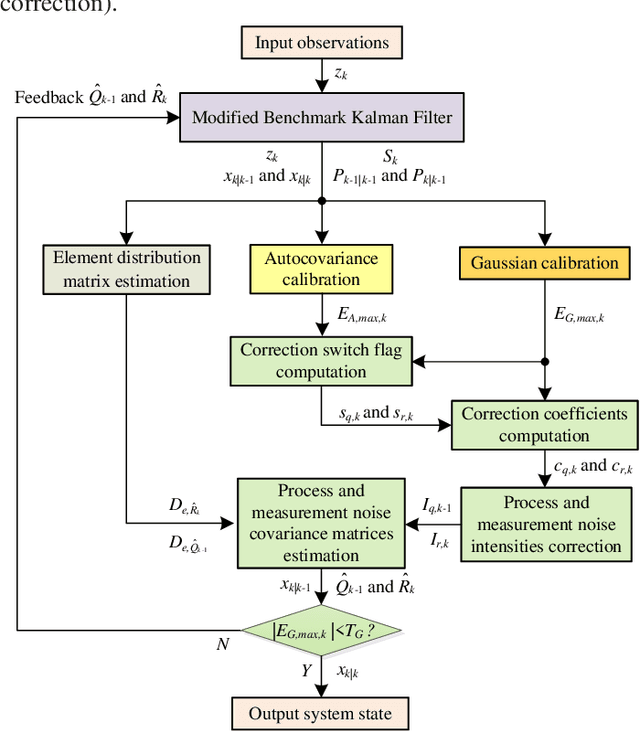
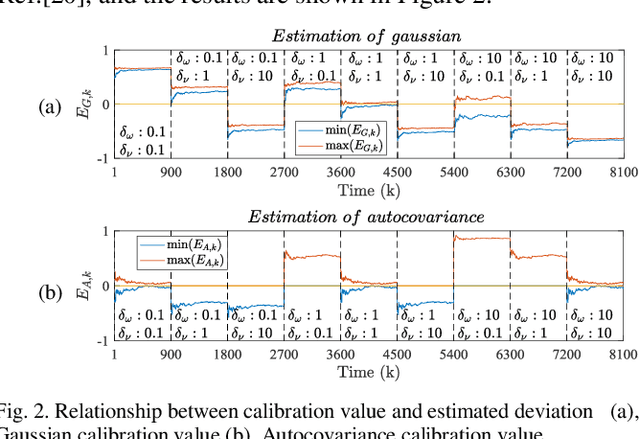
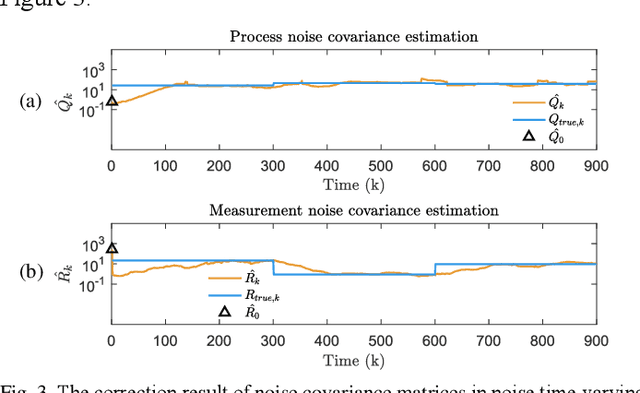
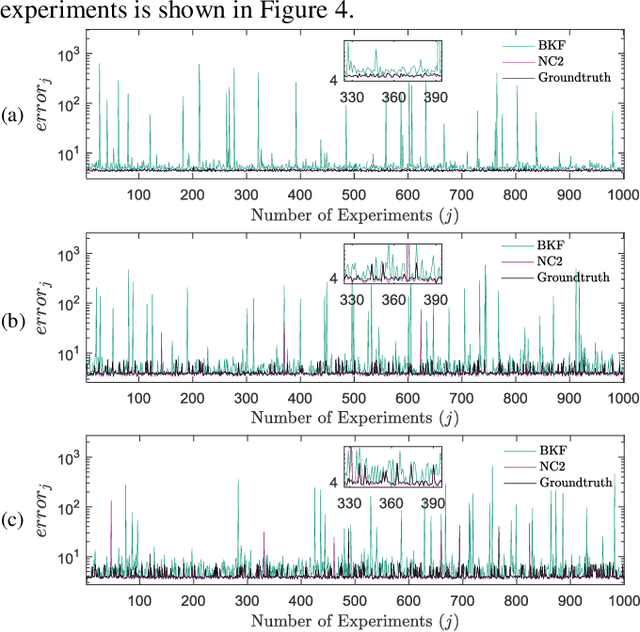
Abstract:Kalman filters are widely used for object tracking, where process and measurement noise are usually considered accurately known and constant. However, the exact known and constant assumptions do not always hold in practice. For example, when lidar is used to track noncooperative targets, the measurement noise is different under different distances and weather conditions. In addition, the process noise changes with the object's motion state, especially when the tracking object is a pedestrian, and the process noise changes more frequently. This paper proposes a new estimation-calibration-correction closed-loop estimation method to estimate the Kalman filter process and measurement noise covariance matrices online. First, we decompose the noise covariance matrix into an element distribution matrix and noise intensity and improve the Sage filter to estimate the element distribution matrix. Second, we propose a calibration method to accurately diagnose the noise intensity deviation. We then propose a correct method to adaptively correct the noise intensity online. Third, under the assumption that the system is detectable, the unbiased and convergence of the proposed method is mathematically proven. Simulation results prove the effectiveness and reliability of the proposed method. Finally, we apply the proposed method to multiobject tracking of lidar and evaluate it on the official KITTI server. The proposed method on the KITTI pedestrian multiobject tracking leaderboard (http://www.cvlibs.net/datasets /kitti/eval_tracking.php) surpasses all existing methods using lidar, proving the feasibility of the method in practical applications. This work provides a new way to improve the performance of the Kalman filter and multiobject tracking.
Densely connected neural networks for nonlinear regression
Jul 29, 2021



Abstract:Densely connected convolutional networks (DenseNet) behave well in image processing. However, for regression tasks, convolutional DenseNet may lose essential information from independent input features. To tackle this issue, we propose a novel DenseNet regression model where convolution and pooling layers are replaced by fully connected layers and the original concatenation shortcuts are maintained to reuse the feature. To investigate the effects of depth and input dimension of proposed model, careful validations are performed by extensive numerical simulation. The results give an optimal depth (19) and recommend a limited input dimension (under 200). Furthermore, compared with the baseline models including support vector regression, decision tree regression, and residual regression, our proposed model with the optimal depth performs best. Ultimately, DenseNet regression is applied to predict relative humidity, and the outcome shows a high correlation (0.91) with observations, which indicates that our model could advance environmental data analysis.
Neural semi-Markov CRF for Monolingual Word Alignment
Jun 16, 2021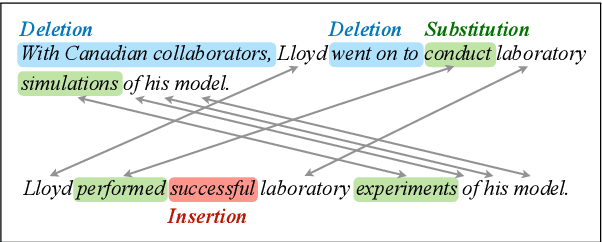
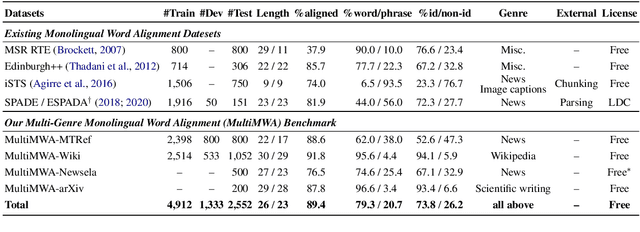
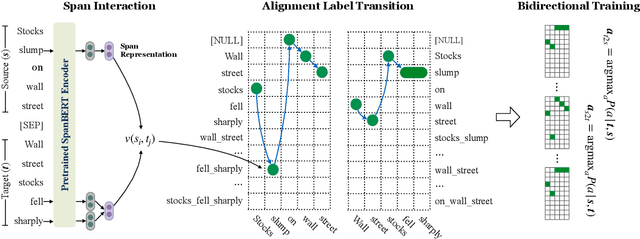

Abstract:Monolingual word alignment is important for studying fine-grained editing operations (i.e., deletion, addition, and substitution) in text-to-text generation tasks, such as paraphrase generation, text simplification, neutralizing biased language, etc. In this paper, we present a novel neural semi-Markov CRF alignment model, which unifies word and phrase alignments through variable-length spans. We also create a new benchmark with human annotations that cover four different text genres to evaluate monolingual word alignment models in more realistic settings. Experimental results show that our proposed model outperforms all previous approaches for monolingual word alignment as well as a competitive QA-based baseline, which was previously only applied to bilingual data. Our model demonstrates good generalizability to three out-of-domain datasets and shows great utility in two downstream applications: automatic text simplification and sentence pair classification tasks.
Neural CRF Model for Sentence Alignment in Text Simplification
May 18, 2020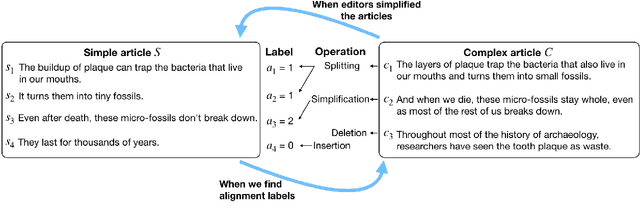
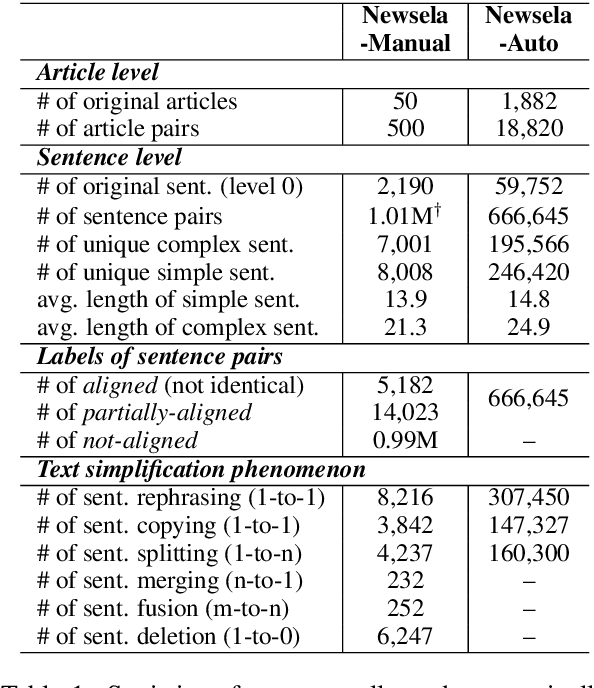
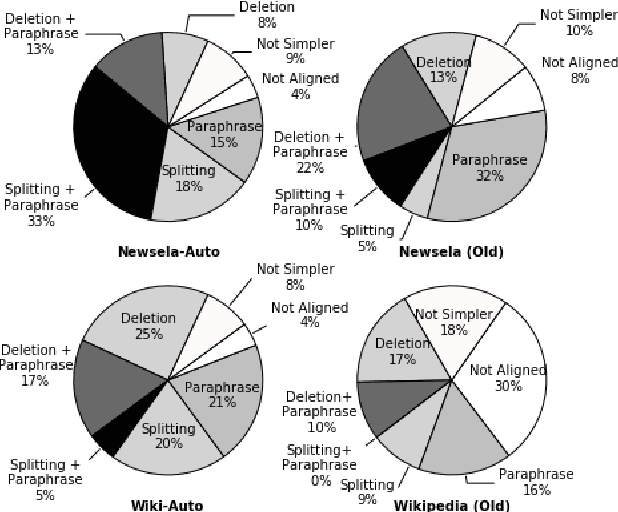

Abstract:The success of a text simplification system heavily depends on the quality and quantity of complex-simple sentence pairs in the training corpus, which are extracted by aligning sentences between parallel articles. To evaluate and improve sentence alignment quality, we create two manually annotated sentence-aligned datasets from two commonly used text simplification corpora, Newsela and Wikipedia. We propose a novel neural CRF alignment model which not only leverages the sequential nature of sentences in parallel documents but also utilizes a neural sentence pair model to capture semantic similarity. Experiments demonstrate that our proposed approach outperforms all the previous work on monolingual sentence alignment task by more than 5 points in F1. We apply our CRF aligner to construct two new text simplification datasets, Newsela-Auto and Wiki-Auto, which are much larger and of better quality compared to the existing datasets. A Transformer-based seq2seq model trained on our datasets establishes a new state-of-the-art for text simplification in both automatic and human evaluation.
Discourse Level Factors for Sentence Deletion in Text Simplification
Nov 26, 2019



Abstract:This paper presents a data-driven study focusing on analyzing and predicting sentence deletion --- a prevalent but understudied phenomenon in document simplification --- on a large English text simplification corpus. We inspect various document and discourse factors associated with sentence deletion, using a new manually annotated sentence alignment corpus we collected. We reveal that professional editors utilize different strategies to meet readability standards of elementary and middle schools. To predict whether a sentence will be deleted during simplification to a certain level, we harness automatically aligned data to train a classification model. Evaluated on our manually annotated data, our best models reached F1 scores of 65.2 and 59.7 for this task at the levels of elementary and middle school, respectively. We find that discourse level factors contribute to the challenging task of predicting sentence deletion for simplification.
 Add to Chrome
Add to Chrome Add to Firefox
Add to Firefox Add to Edge
Add to Edge